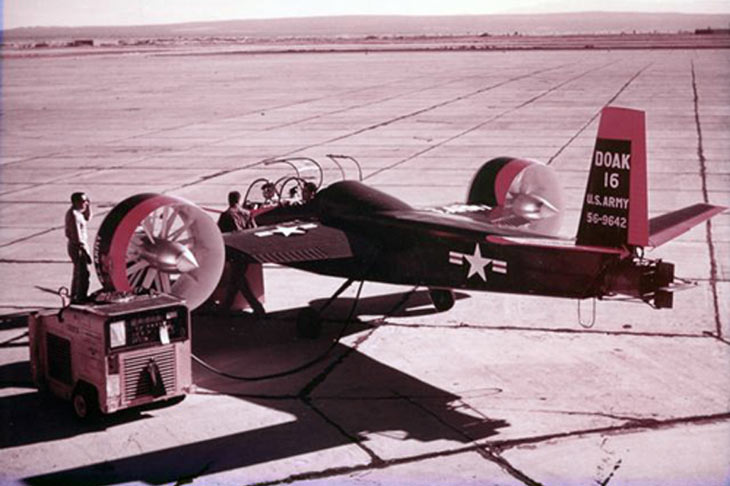DOAK
Model 16 VZ-4 VTOL Aircraft
The DOAK Model 16, or VZ-4 as it was perhaps better known, was
a prototype VTOL aircraft developed by the Doak Aircraft Company
for the U.S. Army during the '50s and early '60s.
The aircraft had been proposed to the U.S. Army in 1950 by the company's
founder, Edmund R. Doak. The top brass were impressed by the idea
of an aircraft which could take off and land vertically, hover,
fly backwards, while also offer a higher top speed and longer range
than a conventional helicopter.
The DOAK VZ-4 used two ducted fans mounted on the end of its stubby
wings for propulsion and lift. The original engine was an 840 horsepower
Lycoming YT53 turboprop, but this was later upgraded to a 1,000
horsepower T53-L-1 engine. The fans were positioned vertically for
takeoff and landing, and rotated to a horizontal orientation for
horizontal flight. The VZ-4 was the first aircraft to use this form
of VTOL flight.
The VZ-4 was built around a tubular metal frame with metal wings
and a tail section. The nosecone was formed from fiberglass. Various
other elements of the aircraft were taken from existing models.
The landing gear was from a humble Cessna 182, the duct actuators
were lifted from a Lockheed T-33 Shooting Start jet, while the two
seats were the same as those used in the North American P-51 Mustang.

The DOAK VZ-4 made its first test flight in early 1958. On February
25th 1958 the aircraft hovered for the first time, and over a year
later, in May 1959 the first transition from vertical flight to
horizontal flight and back again successfully took place.
Overall the DOAK VZ-4 proved to live up to its expectations, a remarkable
feat for a prototype VTOL aircraft, and the very first to explore
the rotating ducted-fan layout. However it wasn't without problems.
Firstly its VTOL take of and landing performance wasn't great, and
during transition from vertical to horizontal flight it had a tendency
to nose up.
After further testing during the summer of 1959 the U.S. Army accepted
the prototype in September of that year. The aircraft received the
designation VZ-4DA and was sent to the NASA Langley Research Center
in Hampton, Virginia.
Unfortunately for the VZ-4 project, the Doak Aircraft Company ran
into financial problems in 1960, resulting in funding for development
for the project being diverted elsewhere. Douglas Aircraft bought
the rights and engineering files to continue development, and even
hired four engineers from Doak to continue work on the aircraft.
Testing and development of the VZ-4 continued for a further 3 years
until the U.S. Army themselves decided that they would put their
faith, and money, into conventional helicopters, and they withdrew
funding entirely for the project and terminated testing in 1963.
Happily however, the groundbreaking DOAK VZ-4 escaped the crusher,
and it is currently held on display at the U.S. Army Transportation
Museum at Fort Eustis, Virginia.
|

